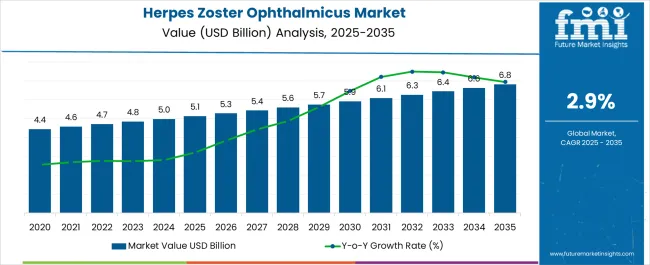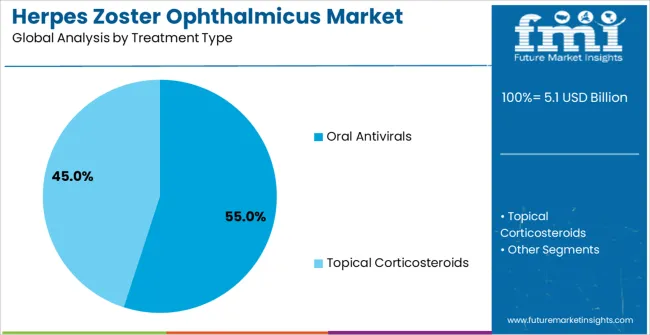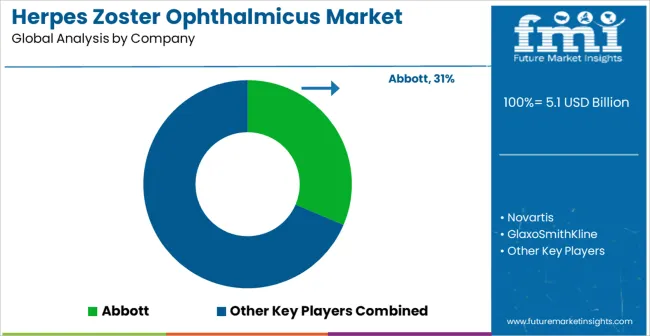The Herpes Zoster Ophthalmicus Market is estimated to be valued at USD 5.1 billion in 2025 and is projected to reach USD 6.8 billion by 2035, registering a compound annual growth rate (CAGR) of 2.9% over the forecast period.

| Metric | Value |
|---|---|
| Herpes Zoster Ophthalmicus Market Estimated Value in (2025 E) | USD 5.1 billion |
| Herpes Zoster Ophthalmicus Market Forecast Value in (2035 F) | USD 6.8 billion |
| Forecast CAGR (2025 to 2035) | 2.9% |
The Herpes Zoster Ophthalmicus market is experiencing steady growth driven by the rising prevalence of varicella-zoster virus reactivation affecting ocular health, particularly among older adults and immunocompromised populations. The future outlook for this market is shaped by increasing awareness regarding early diagnosis and timely treatment of ocular shingles to prevent complications such as vision loss. The demand is further supported by advances in antiviral therapy that improve patient outcomes and reduce recurrence rates.
Healthcare infrastructure expansion and the growing number of hospital visits for ophthalmic conditions are contributing to market growth. Additionally, the increasing focus on patient-centered care and rapid access to effective treatments is driving adoption.
The availability of advanced formulations that allow for better bioavailability and targeted delivery also supports the market expansion As healthcare providers emphasize preventive strategies and early intervention, the market is expected to maintain robust growth, with opportunities in both emerging and developed regions for effective management of Herpes Zoster Ophthalmicus.
The herpes zoster ophthalmicus market is segmented by route of administration, treatment type, distribution channel, and geographic regions. By route of administration, herpes zoster ophthalmicus market is divided into Injectable, Oral, and Topical. In terms of treatment type, herpes zoster ophthalmicus market is classified into Oral Antivirals and Topical Corticosteroids. Based on distribution channel, herpes zoster ophthalmicus market is segmented into Hospitals Pharmacies, Online Stores, Drug Stores, and Retail Stores. Regionally, the herpes zoster ophthalmicus industry is classified into North America, Latin America, Western Europe, Eastern Europe, Balkan & Baltic Countries, Russia & Belarus, Central Asia, East Asia, South Asia & Pacific, and the Middle East & Africa.

The injectable route of administration segment is projected to hold 40.0% of the Herpes Zoster Ophthalmicus market revenue share in 2025, making it a leading administration method. This prominence is driven by the ability of injectable formulations to provide rapid therapeutic effects, particularly in severe or acute cases where immediate antiviral action is required. Injectable delivery ensures higher bioavailability and precise dosing, which is critical for managing ocular complications effectively.
The segment has benefited from technological improvements in formulation stability and patient safety, enabling better treatment adherence. Additionally, the injectable route is preferred in clinical settings, such as hospitals and specialty ophthalmic centers, where healthcare professionals can administer and monitor treatment.
The increasing awareness among clinicians regarding the efficacy of injectable antivirals in preventing vision-threatening complications has further reinforced its adoption Overall, the segment’s growth is influenced by the critical role of injectable antivirals in managing acute manifestations of Herpes Zoster Ophthalmicus efficiently.

The oral antivirals treatment type segment is expected to account for 55.0% of the Herpes Zoster Ophthalmicus market revenue share in 2025, positioning it as the leading treatment modality. Growth in this segment has been driven by the convenience and ease of administration of oral medications, allowing patients to complete therapy at home without frequent hospital visits. Oral antivirals provide systemic action that effectively reduces viral replication and mitigates the severity of ocular symptoms.
The segment has benefited from improved formulations with enhanced bioavailability and tolerability, ensuring patient adherence. Rising patient awareness and early diagnosis practices have also encouraged the adoption of oral antivirals as the primary treatment.
Additionally, oral therapy offers cost-effective and scalable options for large patient populations, supporting broader market penetration The combination of convenience, effectiveness, and growing acceptance among healthcare providers and patients continues to underpin the dominance of oral antivirals in the market.

The hospitals pharmacies distribution channel segment is projected to hold 50.0% of the Herpes Zoster Ophthalmicus market revenue share in 2025, making it the leading distribution channel. This growth is driven by the preference for hospital pharmacies as primary points of access for both injectable and oral antiviral therapies. Hospital pharmacies provide reliable availability of advanced formulations and allow for professional guidance on proper administration and dosage.
The segment has benefited from the increasing number of hospital visits for ocular shingles and the role of hospitals in managing severe or complicated cases. Additionally, integration of hospital pharmacies with clinical management systems enhances monitoring, patient counseling, and adherence to treatment protocols.
The centralization of treatment in hospital pharmacies ensures quality control, timely delivery, and professional supervision, which are critical for managing Herpes Zoster Ophthalmicus effectively These factors collectively support the sustained growth and dominance of this distribution channel in the market.
Herpes zoster ophthalmicus also known as shingles, is a viral disease that causes unilateral painful skin rash in the fifth cranial nerve that is shared by the ocular adnexa and the eye. It mainly occurs in older adults after the reactivation of Latent Varicella-Zoster Virus (VZV) which is present in the cerebral or sensory spinal ganglia.
It negatively affects the immune system of the host and the incidence of this condition grows with age. Thus, it is commonly found in people over the age of 60 years.
Several cases of this disease showcase a prodromal period of eye pain, fever, headache, and malaise before the eruption of the skin rash. A shingles vaccination is recommended by healthcare institutions for the geriatric population suffering from this condition.

| Country | CAGR |
|---|---|
| China | 3.9% |
| India | 3.6% |
| Germany | 3.3% |
| Brazil | 3.0% |
| USA | 2.8% |
| UK | 2.5% |
| Japan | 2.2% |
The Herpes Zoster Ophthalmicus Market is expected to register a CAGR of 2.9% during the forecast period, exhibiting varied country level momentum. China leads with the highest CAGR of 3.9%, followed by India at 3.6%. Developed markets such as Germany, France, and the UK continue to expand steadily, while the USA is likely to grow at consistent rates. Japan posts the lowest CAGR at 2.2%, yet still underscores a broadly positive trajectory for the global Herpes Zoster Ophthalmicus Market. In 2024, Germany held a dominant revenue in the Western Europe market and is expected to grow with a CAGR of 3.3%. The USA Herpes Zoster Ophthalmicus Market is estimated to be valued at USD 1.8 billion in 2025 and is anticipated to reach a valuation of USD 1.8 billion by 2035. Sales are projected to rise at a CAGR of 0.0% over the forecast period between 2025 and 2035. While Japan and South Korea markets are estimated to be valued at USD 279.5 million and USD 173.0 million respectively in 2025.

| Item | Value |
|---|---|
| Quantitative Units | USD 5.1 Billion |
| Route of Administration | Injectable, Oral, and Topical |
| Treatment Type | Oral Antivirals and Topical Corticosteroids |
| Distribution Channel | Hospitals Pharmacies, Online Stores, Drug Stores, and Retail Stores |
| Regions Covered | North America, Europe, Asia-Pacific, Latin America, Middle East & Africa |
| Country Covered | United States, Canada, Germany, France, United Kingdom, China, Japan, India, Brazil, South Africa |
| Key Companies Profiled | Abbott, Novartis, GlaxoSmithKline, Merck, TEVA, Cipla, Mylan, and Cadila Pharmaceuticals |
The global herpes zoster ophthalmicus market is estimated to be valued at USD 5.1 billion in 2025.
The market size for the herpes zoster ophthalmicus market is projected to reach USD 6.8 billion by 2035.
The herpes zoster ophthalmicus market is expected to grow at a 2.9% CAGR between 2025 and 2035.
The key product types in herpes zoster ophthalmicus market are injectable, oral and topical.
In terms of treatment type, oral antivirals segment to command 55.0% share in the herpes zoster ophthalmicus market in 2025.






Our Research Products

The "Full Research Suite" delivers actionable market intel, deep dives on markets or technologies, so clients act faster, cut risk, and unlock growth.

The Leaderboard benchmarks and ranks top vendors, classifying them as Established Leaders, Leading Challengers, or Disruptors & Challengers.

Locates where complements amplify value and substitutes erode it, forecasting net impact by horizon

We deliver granular, decision-grade intel: market sizing, 5-year forecasts, pricing, adoption, usage, revenue, and operational KPIs—plus competitor tracking, regulation, and value chains—across 60 countries broadly.

Spot the shifts before they hit your P&L. We track inflection points, adoption curves, pricing moves, and ecosystem plays to show where demand is heading, why it is changing, and what to do next across high-growth markets and disruptive tech

Real-time reads of user behavior. We track shifting priorities, perceptions of today’s and next-gen services, and provider experience, then pace how fast tech moves from trial to adoption, blending buyer, consumer, and channel inputs with social signals (#WhySwitch, #UX).

Partner with our analyst team to build a custom report designed around your business priorities. From analysing market trends to assessing competitors or crafting bespoke datasets, we tailor insights to your needs.
Supplier Intelligence
Discovery & Profiling
Capacity & Footprint
Performance & Risk
Compliance & Governance
Commercial Readiness
Who Supplies Whom
Scorecards & Shortlists
Playbooks & Docs
Category Intelligence
Definition & Scope
Demand & Use Cases
Cost Drivers
Market Structure
Supply Chain Map
Trade & Policy
Operating Norms
Deliverables
Buyer Intelligence
Account Basics
Spend & Scope
Procurement Model
Vendor Requirements
Terms & Policies
Entry Strategy
Pain Points & Triggers
Outputs
Pricing Analysis
Benchmarks
Trends
Should-Cost
Indexation
Landed Cost
Commercial Terms
Deliverables
Brand Analysis
Positioning & Value Prop
Share & Presence
Customer Evidence
Go-to-Market
Digital & Reputation
Compliance & Trust
KPIs & Gaps
Outputs
Full Research Suite comprises of:
Market outlook & trends analysis
Interviews & case studies
Strategic recommendations
Vendor profiles & capabilities analysis
5-year forecasts
8 regions and 60+ country-level data splits
Market segment data splits
12 months of continuous data updates
DELIVERED AS:
PDF EXCEL ONLINE
Herpes Labialis Treatment Market – Trends & Forecast 2025 to 2035
Herpes Simplex Keratitis Treatment Market – Trends & Forecast 2025 to 2035
Genital Herpes Treatment Market is segmented by transplant type, disease indication, and end user from 2025 to 2035
Varicella Zoster Infection Treatment Market Size and Share Forecast Outlook 2025 to 2035

Thank you!
You will receive an email from our Business Development Manager. Please be sure to check your SPAM/JUNK folder too.
Chat With
MaRIA